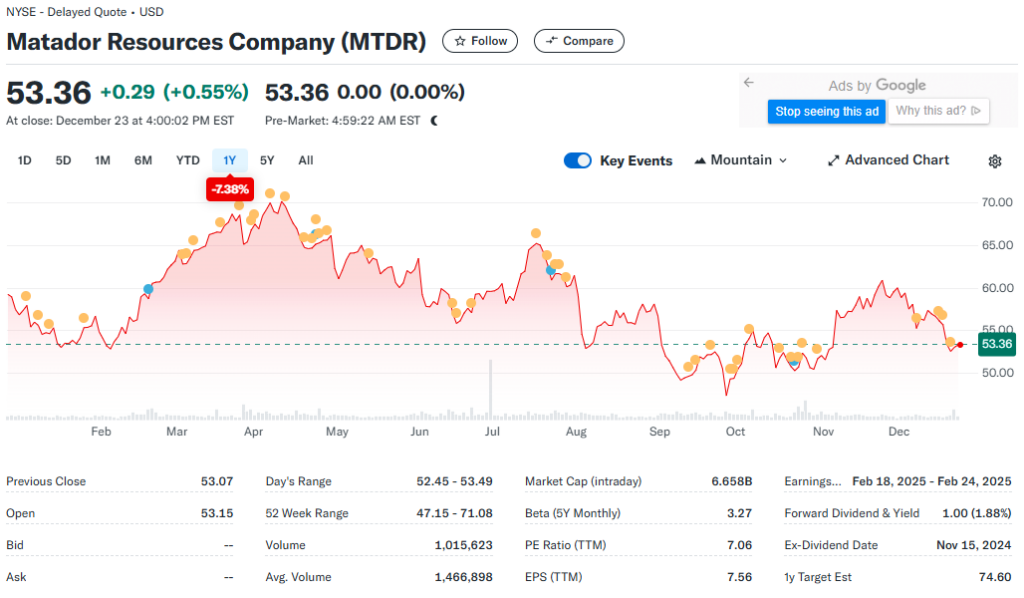Matador Resources Company (NYSE: MTDR) has emerged as a prominent player in the energy sector, focusing on the exploration, development, and production of oil and natural gas. Founded in 2003, the Dallas, Texas-based company operates primarily in the Delaware Basin, one of the most prolific oil and natural gas plays in North America. As energy prices fluctuate and the industry evolves, Matador’s operational efficiency, strategic growth, and financial performance make it a compelling choice for investors seeking exposure to the energy market.
This article provides an in-depth analysis of Matador Resources Company, examining its financial performance, operational strengths, market position, and growth prospects. By understanding these key elements, potential investors can make informed decisions about whether MTDR aligns with their investment goals.
Industry Overview
The oil and natural gas industry is cyclical and influenced by various factors such as global supply and demand, geopolitical events, regulatory policies, and technological advancements. Over the past decade, the industry has seen significant volatility, with prices reaching historic highs and lows. Matador Resources operates within the upstream segment, focusing on exploration and production (E&P). This segment’s profitability is heavily dependent on efficient operations, cost management, and favorable commodity prices.
The Delaware Basin, part of the Permian Basin, is a strategic focus for Matador. It boasts some of the lowest breakeven costs in the U.S., making it a preferred location for many E&P companies. As the world transitions to cleaner energy, oil and gas companies face increased scrutiny, but Matador’s focus on operational efficiency and its diversified portfolio position it well to navigate these challenges.

Financial Performance
Matador’s financial metrics highlight its resilience and growth potential. In recent quarters, the company has demonstrated robust revenue growth driven by higher production volumes and favorable commodity prices. For instance, in the third quarter of 2023, Matador reported:
- Revenue of $660 million, reflecting a year-over-year increase of 12%.
- Net income of $230 million, up from $180 million in the previous year.
- EBITDA of $400 million, showcasing strong operational efficiency.
Matador’s disciplined approach to capital spending has allowed it to maintain a healthy balance sheet. The company’s debt-to-equity ratio stands at a manageable level, ensuring financial flexibility. Additionally, Matador’s free cash flow generation has enabled it to return value to shareholders through dividends and share repurchases. These financial metrics underscore the company’s ability to weather market volatility while pursuing growth opportunities.
Operational Strengths
Matador Resources’ operational efficiency is a cornerstone of its success. The company’s focus on technological innovation and cost optimization has allowed it to achieve competitive breakeven costs. Key operational highlights include:
- Delaware Basin Focus: Matador’s operations are concentrated in the Delaware Basin, where it holds approximately 150,000 net acres. The basin’s high-quality reserves and infrastructure provide a competitive advantage.
- Production Growth: Matador has consistently increased its production volumes, averaging over 125,000 barrels of oil equivalent per day (BOE/d) in 2023. This growth has been supported by efficient drilling techniques and advanced completion practices.
- Midstream Integration: Through its subsidiary San Mateo Midstream, Matador has integrated midstream capabilities, including gathering, processing, and transportation of oil and natural gas. This integration enhances operational efficiency and reduces reliance on third-party services.
- Environmental Commitment: Recognizing the growing importance of ESG (Environmental, Social, and Governance) factors, Matador has implemented measures to reduce its environmental footprint. These include reducing flaring, minimizing methane emissions, and adopting sustainable water management practices.
Competitive Position
Matador Resources operates in a highly competitive industry, but its strategic focus and operational excellence set it apart. Key competitive advantages include:
- Cost Leadership: Matador’s ability to maintain low production costs provides a buffer against price volatility, ensuring profitability even during downturns.
- Strategic Acreage: The company’s prime acreage in the Delaware Basin ensures access to high-quality reserves, contributing to long-term production growth.
- Integrated Operations: San Mateo Midstream enhances Matador’s control over its value chain, improving efficiency and reducing costs.
- Experienced Management: Matador’s leadership team has a proven track record of navigating market challenges and delivering shareholder value.
Growth Prospects
Matador Resources is well-positioned for future growth, driven by several factors:
- Drilling Inventory: The company’s extensive inventory of high-quality drilling locations in the Delaware Basin provides a long runway for production growth.
- Technological Advancements: Matador’s adoption of advanced drilling and completion techniques enhances well productivity and reduces costs.
- Acquisition Strategy: Strategic acquisitions have been a key component of Matador’s growth. For example, the 2022 acquisition of Advance Energy Partners added approximately 18,500 net acres to its Delaware Basin portfolio.
- Market Tailwinds: Rising global energy demand and constrained supply provide a favorable environment for oil and gas producers. Matador’s efficient operations enable it to capitalize on these trends.
- Shareholder Returns: Matador’s commitment to returning capital to shareholders through dividends and share buybacks enhances its attractiveness as an investment.
Risks and Challenges
While Matador Resources has a strong growth trajectory, investors should be aware of potential risks:
- Commodity Price Volatility: The company’s revenue and profitability are directly tied to oil and natural gas prices, which are subject to fluctuations.
- Regulatory and Environmental Pressures: Increasing regulations and environmental concerns could impact operations and profitability.
- Capital Intensity: Exploration and production activities require significant capital investment, posing risks during periods of low commodity prices.
- Geopolitical Factors: Global political events can influence energy prices and supply chains, creating uncertainty for E&P companies.
- Market Competition: The oil and gas industry is highly competitive, and Matador faces challenges from both large multinational corporations and smaller independent producers.
Conclusion
Matador Resources Company presents a compelling investment opportunity in the energy sector. Its strategic focus on the Delaware Basin, operational efficiency, financial discipline, and growth-oriented approach position it well to navigate industry challenges and capitalize on market opportunities. While risks such as commodity price volatility and regulatory pressures exist, Matador’s competitive strengths and growth prospects make it a solid choice for investors seeking exposure to the upstream energy segment.
For investors with a moderate to high risk tolerance and a belief in the long-term prospects of the oil and gas industry, Matador Resources Company offers a balanced mix of stability and growth potential. As always, investors should conduct their due diligence and consider their individual financial goals before making investment decisions.












